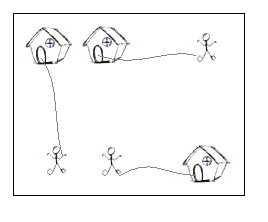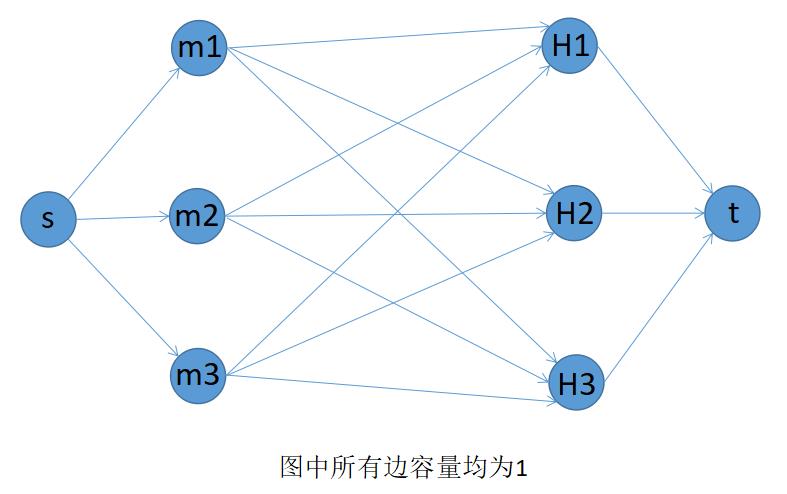POJ 2195 - Going Home - [最小费用最大流][MCMF模板]
Posted tags:
篇首语:本文由小常识网(cha138.com)小编为大家整理,主要介绍了POJ 2195 - Going Home - [最小费用最大流][MCMF模板]相关的知识,希望对你有一定的参考价值。
题目链接:http://poj.org/problem?id=2195
Time Limit: 1000MS Memory Limit: 65536K
Description
On a grid map there are n little men and n houses. In each unit time, every little man can move one unit step, either horizontally, or vertically, to an adjacent point. For each little man, you need to pay a $1 travel fee for every step he moves, until he enters a house. The task is complicated with the restriction that each house can accommodate only one little man.
Your task is to compute the minimum amount of money you need to pay in order to send these n little men into those n different houses. The input is a map of the scenario, a \'.\' means an empty space, an \'H\' represents a house on that point, and am \'m\' indicates there is a little man on that point.

You can think of each point on the grid map as a quite large square, so it can hold n little men at the same time; also, it is okay if a little man steps on a grid with a house without entering that house.
Your task is to compute the minimum amount of money you need to pay in order to send these n little men into those n different houses. The input is a map of the scenario, a \'.\' means an empty space, an \'H\' represents a house on that point, and am \'m\' indicates there is a little man on that point.

You can think of each point on the grid map as a quite large square, so it can hold n little men at the same time; also, it is okay if a little man steps on a grid with a house without entering that house.
Input
There are one or more test cases in the input. Each case starts with a line giving two integers N and M, where N is the number of rows of the map, and M is the number of columns. The rest of the input will be N lines describing the map. You may assume both N and M are between 2 and 100, inclusive. There will be the same number of \'H\'s and \'m\'s on the map; and there will be at most 100 houses. Input will terminate with 0 0 for N and M.
Output
For each test case, output one line with the single integer, which is the minimum amount, in dollars, you need to pay.
Sample Input
2 2 .m H. 5 5 HH..m ..... ..... ..... mm..H 7 8 ...H.... ...H.... ...H.... mmmHmmmm ...H.... ...H.... ...H.... 0 0
Sample Output
2 10 28
转载请注明出处:優YoU http://blog.csdn.net/lyy289065406/article/details/6732762 大致题意: 给定一个N*M的地图,地图上有若干个man和house,且man与house的数量一致。man每移动一格需花费$1(即单位费用=单位距离),一间house只能入住一个man。现在要求所有的man都入住house,求最小费用。
构图: 把man作为一个顶点集合U,house作为另一个顶点集合V,把U中所有点到V中所有点addedge{from∈U,to∈V,cap=1,cost=两点间哈密顿距离},构成一个多源多汇的二分图。 构造一个超级源点s和超级汇点t:s与U中所有点相连,费用为0,容量为1;V中所有点与t相连,费用为0,容量为1。
这种构图思路很简单,我们建立起的二分图:

不难想象,maxflow必然等于the number of men(or the number of houses),在上图的例子中,即为3;
由于我们在所有man点与house点间建立的边容量为1,显然,最大流保证了:
①所有man都能到house里;
②一个man只进到一间house,一间house只有一个man;
就像在上图中,最大流的情况下,每个m[i]只能选一个H[j],而且i,j也不能重复;
这恰好就满足了题目所给的要求,然后,只要我们在m[i]到H[j]的边上加上cost=Hamiltonian_distance(m[i],H[j]),求出最小费用就是答案啦。
1 #include<cstdio> 2 #include<cstdlib> 3 #include<cstring> 4 #include<vector> 5 #include<queue> 6 #define MAXN 203 7 #define INF 0x3f3f3f3f 8 using namespace std; 9 struct Edge{ 10 int u,v,c,f,a; 11 }; 12 struct MCMF 13 { 14 int s,t; 15 vector<Edge> E; 16 vector<int> G[MAXN]; 17 int vis[MAXN]; 18 int d[MAXN]; 19 int pre[MAXN]; 20 int aug[MAXN]; 21 void init(int l,int r) 22 { 23 for(int i=l;i<=r;i++) G[i].clear(); 24 E.clear(); 25 } 26 void addedge(int from,int to,int cap,int cost) 27 { 28 E.push_back((Edge){from,to,cap,0,cost}); 29 E.push_back((Edge){to,from,0,0,-cost}); 30 int m=E.size(); 31 G[from].push_back(m-2); 32 G[to].push_back(m-1); 33 } 34 bool SPFA(int s,int t,int &flow,int &cost) 35 { 36 memset(d,INF,sizeof(d)); 37 memset(vis,0,sizeof(vis)); 38 d[s]=0, vis[s]=1, pre[s]=0, aug[s]=INF; 39 queue<int> q; 40 q.push(s); 41 while(!q.empty()) 42 { 43 int now=q.front(); q.pop(); 44 vis[now]=0; 45 for(int i=0;i<G[now].size();i++) 46 { 47 Edge& e=E[G[now][i]]; 48 int nex=e.v; 49 if(e.c>e.f && d[nex]>d[now]+e.a) 50 { 51 d[nex]=d[now]+e.a; 52 pre[nex]=G[now][i]; 53 aug[nex]=min(aug[now],e.c-e.f); 54 if(!vis[nex]) 55 { 56 q.push(nex); 57 vis[nex]=1; 58 } 59 } 60 } 61 } 62 if(d[t]==INF) return 0; 63 flow+=aug[t]; 64 cost+=d[t]*aug[t]; 65 for(int i=t;i!=s;i=E[pre[i]].u) 66 { 67 E[pre[i]].f+=aug[t]; 68 E[pre[i]^1].f-=aug[t]; 69 } 70 return 1; 71 } 72 73 int mincost() 74 { 75 int flow=0,cost=0; 76 while(SPFA(s,t,flow,cost)); 77 return cost; 78 } 79 }mcmf; 80 81 char map[103][103]; 82 struct Node{int row,col;}; 83 int Hami_dist(Node a,Node b){return abs(a.row-b.row) + abs(a.col-b.col);} 84 85 int main() 86 { 87 int N,M;//N行,M列 88 while(scanf("%d%d",&N,&M) && N!=0) 89 { 90 vector<Node> men,houses; 91 for(int i=1;i<=N;i++) scanf("%s",map[i]+1); 92 for(int i=1;i<=N;i++) 93 { 94 for(int j=1;j<=M;j++) 95 { 96 if(map[i][j]==\'m\') men.push_back((Node){i,j}); 97 if(map[i][j]==\'H\') houses.push_back((Node){i,j}); 98 } 99 } 100 int n=men.size(); 101 mcmf.init(0,2*n+1); 102 mcmf.s=0, mcmf.t=2*n+1; 103 for(int i=0;i<n;i++) 104 { 105 mcmf.addedge(mcmf.s,i+1,1,0); 106 for(int j=0;j<n;j++) 107 { 108 if(i==0) mcmf.addedge(j+1+n,mcmf.t,1,0); 109 mcmf.addedge(i+1,j+1+n,1,Hami_dist(men[i],houses[j])); 110 } 111 } 112 printf("%d\\n",mcmf.mincost()); 113 } 114 }
以上是关于POJ 2195 - Going Home - [最小费用最大流][MCMF模板]的主要内容,如果未能解决你的问题,请参考以下文章